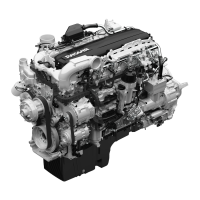PEC017
5/3/2018 Page 48 of 105
Engine Requested Speed Control Conditions
3 = Stability Optimized for driveline
engaged and/or in lockup condition 2
(e.g., PTO driveline)
Override Control Mode Priority
3 = Low Priority (below transmission,
ABS, brakes)
Engine Requested Speed/Speed Limit
This is the engine speed which the
engine is expected to operate at if the
speed control mode is active, or the
engine speed which the engine is not
expected to exceed if the speed limit
mode is active. Applicable when
EngOverrideCtrlMode (SPN 695) = 1 or 3
Engine Requested Torque/Torque Limit
Controls or limits the output torque as a
percentage of reference engine torque.
Applicable when EngOverrideCtrlMode
(SPN 695) = 2 or 3
Engine Requested Torque - High Resolution
High-resolution modifier of torque
request. Adds fractional torque request
of resolution 0.125% to value of SPN 518
The message counter is used to detect
situations where the transmitting ECU
malfunction repeats the same frame all
the time. The receiver of the
information may use the counter
parameter to detect this situation. The
transmitting device will increase the
message counter in every cycle. The
message counter will count from 0 to 7
and then wrap.
The values 0x8 thru 0xE are SAE reserved
and should be ignored by the receiver.
Value 0xF (all bits set to 1) will indicate
that the message counter is not
available.
The checksum is used to verify the signal
path from the transmitting device to the
receiving device.
The checksum is the sum of the high
nibble and the low nibble of the sum of
the identifier, the first 7 data bytes and
the message counter. It is calculated as
follows:
Checksum = (Byte1 + Byte2 + Byte3 +
Byte4 + Byte5 + Byte6 + Byte7 + message
counter & 0x0F + message ID low byte +
message ID mid low byte + message ID
mid high byte + message ID high byte)
Checksum = ((Checksum >> 6) +
(Checksum >>3) + Checksum) & 0x07
Value 0xF (all bits set to 1) will indicate
that the checksum is not available.

